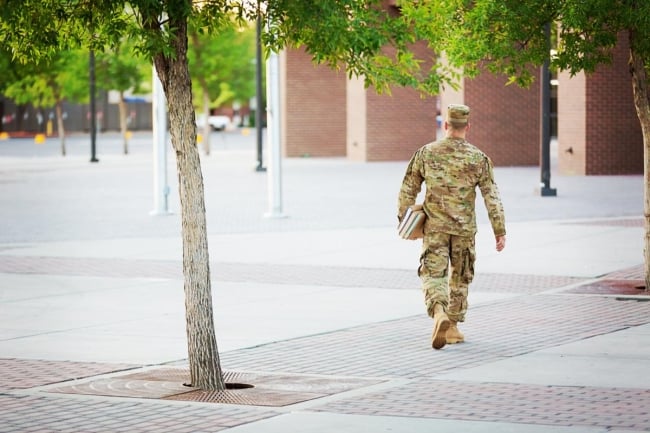You have /5 articles left.
Sign up for a free account or log in.

MivPiv/Getty Images
The landmark Post-9/11 GI Bill contained a massive expansion of benefits for student veterans, increasing the maximum financial aid benefit from $1,321 per month to $60,000 per semester for some veterans. But the generous subsidies do not pay off for student veterans who likely wouldn’t have attended college without the financial incentives, according to a new working paper published by the National Bureau of Economic Research.
“While college is a good investment for most people, there’s a lot of heterogeneity in the labor market returns,” said Andrew Barr, lead author of the working paper and an associate professor of economics at Texas A&M University. “We can’t just think about college as beneficial for everyone and stop the questioning there.”
Under previous iterations of the GI Bill -- the original 1944 Serviceman’s Readjustment Act and the 1984 Montgomery GI Bill -- student veterans receive flat payments to cover tuition, books and living expenses. The Post-9/11 GI Bill, which was passed in 2008, overhauled the payment model so that veterans receive tuition benefits based on the highest in-state tuition price. They also receive a basic housing allowance that is determined by housing prices within the ZIP code for the institution they attend.
This new model means that some student veterans receive greater benefits than others, the paper showed. For example, student veterans could receive $48,000 for tuition and fees by attending a college in Colorado or Oregon but receive only $5,000 or $6,000 to attend a college in Wyoming or Arkansas.
The working paper’s title -- “You Can’t Handle the Truth: The Effects of the Post-9/11 GI Bill on Higher Education and Earnings” -- quotes an iconic scene from the 1992 film A Few Good Men and acknowledges that many people might be disappointed by its results.
“The results are not probably what people had hoped or expected,” Barr said.
Authors found that beneficiaries of the Post-9/11 GI Bill saw lower wages for seven to nine years after they left the Army compared with their non-college-going peers. The bill lowered earnings by $1,400 on average per veteran across that seven- to nine-year time frame. Veterans are unlikely to recoup those lost earnings during their careers, the paper said.
This stands in stark contrast to earlier versions of the GI Bill, under which eligible veterans saw two to three years of lower earnings before quickly outpacing their non-college-going peers, the paper said.
Authors of the working paper speculate on two potential reasons for the differences in earnings between Post-9/11 GI Bill-eligible veterans and their counterparts. The first is that the generous new benefits may have tipped the scales for veterans who were on the fence about attending college.
“They’ve moved the program from an already relatively generous program to an extraordinarily generous program,” Barr said. “We might think of the types of people who are induced into college by the benefit expansion as the type of people who maybe weren’t that enthusiastic about going to college originally.”
It is also possible that eligible veterans did not select institutions with adequate returns on investment, the paper said.
“You have this group of people who are induced into college by these very generous benefits. They don’t have a lot of guidance or support on how to make their choices,” Barr said. “And it appears that a good fraction of the marginal enrollees -- those who are induced in as a result of the benefit expansion -- may have been choosing institutions that, at least on average, don’t have as good returns.”
Many new participants in the benefits program chose for-profit colleges over four-year public flagship or regional institutions. Previous research shows that students who attend for-profit colleges earn less and are less likely to be employed postgraduation than graduates who attended public colleges.
“It is particularly telling that the largest negative effects of the program accrue to the least skilled veterans,” the paper said. “These are the groups to see the largest overall enrollment increase, with much of that increase concentrated in for-profit institutions at the expense of enrollments in four-year public institutions.”
Veterans who enrolled at two- and four-year public colleges did see an increase in earnings as a result.
This finding could be useful in conversations about other expanded education subsidies, like a potential expansion of the Pell Grant and other education incentives for older nontraditional students, the authors write. While veterans are a unique student demographic, the result of overincentivizing higher education could appear among other student groups, Barr said.
He suggested that the benefits must be coupled with guidance that could help interested veterans pick institutions that will result in a positive return on investment.
While the working paper provides a look at the negative impacts of Post-9/11 GI Bill benefits on some veterans’ earnings, many do succeed as a result of the subsidies, Barr said.
“There almost certainly are many veterans who are going to college and using these benefits and benefiting tremendously,” he said.








